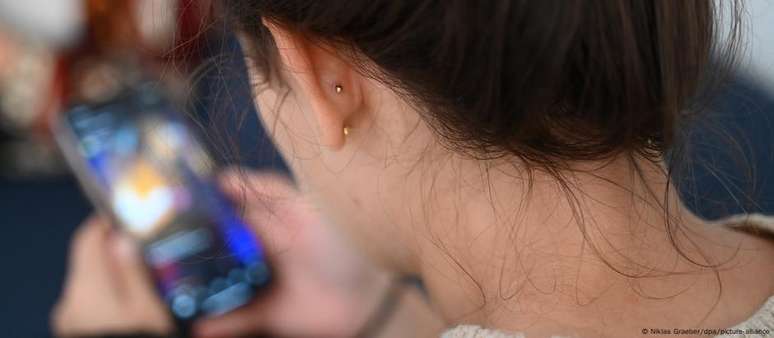The Congress analyzes the proposals to increase the penalties for the crime of dissemination of nudity images created by artificial intelligence. “It was a shock on the day when my daughter showed me a photo of hers without clothes that circulated in conversation groups. I did not imagine that the people who lived with her from a child could do such a thing.”
The report is by Fernanda (fictitious name), mother of a 15 year old, who had photos taken from her social network, altered and transformed into naked using artificial intelligence (AI).
The image, in which the teenager appears with the exposed breast, circulated in a group of conversations of boys who studied in the same class, in a private college of Rio de Janeiro (RJ) last year. After the discovery, the family changed the teenager to school.
“He discovered that a naked photo of hers had been released in the group after a friend of the room saw. My daughter cried a lot and did not want to go back to school anymore. In addition to shame, she has the question that the photo had been changed, presumably, by some colleagues,” says her mother.
To overcome the trauma, the girl follows psychological. In addition, he began to avoid publishing photos on his social networks. “Like any teenager of this age, she liked to take dancing and publish photos. But she was very afraid of what they can do with her photos. Today, when you publish they are only stories, which disappears after a day,” says Fernanda.
Blackmail and extortion
The similar situation had to face Rafaela Ferrari Kley, a master in public international law and a cryptocurrency specialist. He had a photo of his modification with the use of artificial intelligence and with the image that the criminals tried to extort it.
“I received a message on my social network and when I opened I saw that the person asked me Bitcoin not to advertise a naked photo of mine. The image had been stolen from my profile and changed,” he says. Rafaela reports that she has not given the blackmail and did not make the required payment.
“Despite the exhibition, the photo had some imperfections that showed that it was manipulated. So I decided that I would not pay and warned my followers on what was happening,” he adds.
The practice of creating “deep nudes” or false naked that expose women on the internet without the authorization of them has become increasingly common. Cases involving students who have changed and released photos of classmates and even teachers have already been recorded in Sao Paulo, Belo Horizonte, Recife, Rio de Janeiro and Mato Grosso.
Easy access
For the production of assemblies, there are websites and applications designed for this type of editing that “removes clothes” and even simulate the private parts based on common photos. These software, for the most part, are available for free and do not require a lot of technical knowledge for its use.
“This type of crime is happening for some reasons. The first is the abundance of images that people end up leaving the public on social networks. And the second is the progress of artificial intelligence, which allows the creation of this type of image with ease that until then does not exist.
The crime of advertising the manipulated images
The penal code in its article 216-B underlines that it is a crime producing and disseminating manipulated montages and images to have sexual footprints. The penalty for this crime can vary from six months to one year in prison, as well as a fine.
If the images involve children under the age of 18, there is also an article in the statute of the child and teenagers who provide a punishment to those who “simulate the participation of minors in the explicit or pornographic sex scene through adulteration, assembly or modification of photography, video or any other form of visual representation”.
The penalty in these cases varies from one to three years in prison, as well as a fine. The penalty is applied to those who sell, distribute or disclose this type of image by any means.
“Even if the person says that he did not know that the image was false or that he was only transmitting the content, the law includes that the simple act of spreading the unauthorized intimate material already constitutes a crime. The spread of the intimate images, the real or not, without the consent of the victim, the victim moves directly, his detention of combing.
Increase in the penalty for this crime
Invoice 3.821/24 has been approved in the House of Representatives in February and tries to increase the sanction for those who manipulate, produce or divulge false sexual sexual content generated by artificial intelligence or other technological means. The text must be voted by the Senate.
If the bill is approved and becomes law, the crime can be punished with imprisonment from two to six years and a fine. The change involves an increase in the sentence if the victim is a woman, a child, teenager, elderly or disabled and in case of mass diffusion on social networks or digital platforms of manipulated content.
Bill 370/2024 includes the use of artificial intelligence or any other technology that alters the victim’s image or voice as aggravating, which allows the increase in crime of psychological violence against women. The proposal was approved at the congress and is now waiting for the president’s sanction to become law.
“The legislation itself gradually tries to adapt to these new contexts. Now, rather than making the laws more severe, it is important to have a greater applicability of the law and the rapid investigation on these crimes. Because it is often difficult to identify the author of the crime and, consequently, to apply the punishment,” says Lucas Uster, a lawyer who specializes in digital law.
For the Church, in addition to increasing the penalty for those who commit this type of crime, the co -up -off for platforms can be a way for greater supervision in creating this type of content.
Articulated prevention effort
However, experts also affirm that only the criminal response is not enough. An effort is needed between various sectors to prevent and combat this type of crime. The state should invest in digital education since childhood and promote awareness campaigns so that the victims are guided on their rights and how to quickly report this type of content.
“Promoting education and digital citizenship is essential to prevent the creation and dissemination of deep nudes. The educational campaigns should inform the risks associated with the sharing and legal consequences of unauthorized manipulation of content,” says Ron Vanzof, professor of digital law, cyber data protection and head of the National Committee for excuse (Cnciber).
Vanzof also highlights the fundamental role of parents and educators to guide young people on the responsible use of new technologies and “the responsibility of their actions, especially when they can cause pain and suffering to third parties”.
How to report
To report this type of crime, the first step is to collect and preserve all possible tests: screen catches, websites or social networks in which the image was published, for example third -party messages that have received or shared the content.
After collecting the tests, it is important to immediately report the content through the official channels of the platform in which it was published. The complaint is faster, the greater the possibility of stopping to spread and minimize the damage caused.
Then a police report should be presented, preferably in the specialized police stations of computer crime for criminal investigations. If there is no police station specialized in the city, this event can be done in any police station.
Source: Terra
Rose James is a Gossipify movie and series reviewer known for her in-depth analysis and unique perspective on the latest releases. With a background in film studies, she provides engaging and informative reviews, and keeps readers up to date with industry trends and emerging talents.




![Tomorrow we belong to: What awaits you in the 2054 episode of Thursday on October 16, 2025 [SPOILERS] Tomorrow we belong to: What awaits you in the 2054 episode of Thursday on October 16, 2025 [SPOILERS]](https://fr.web.img6.acsta.net/img/3f/3b/3f3b56983d580fbe5136143378b45a29.jpg)


